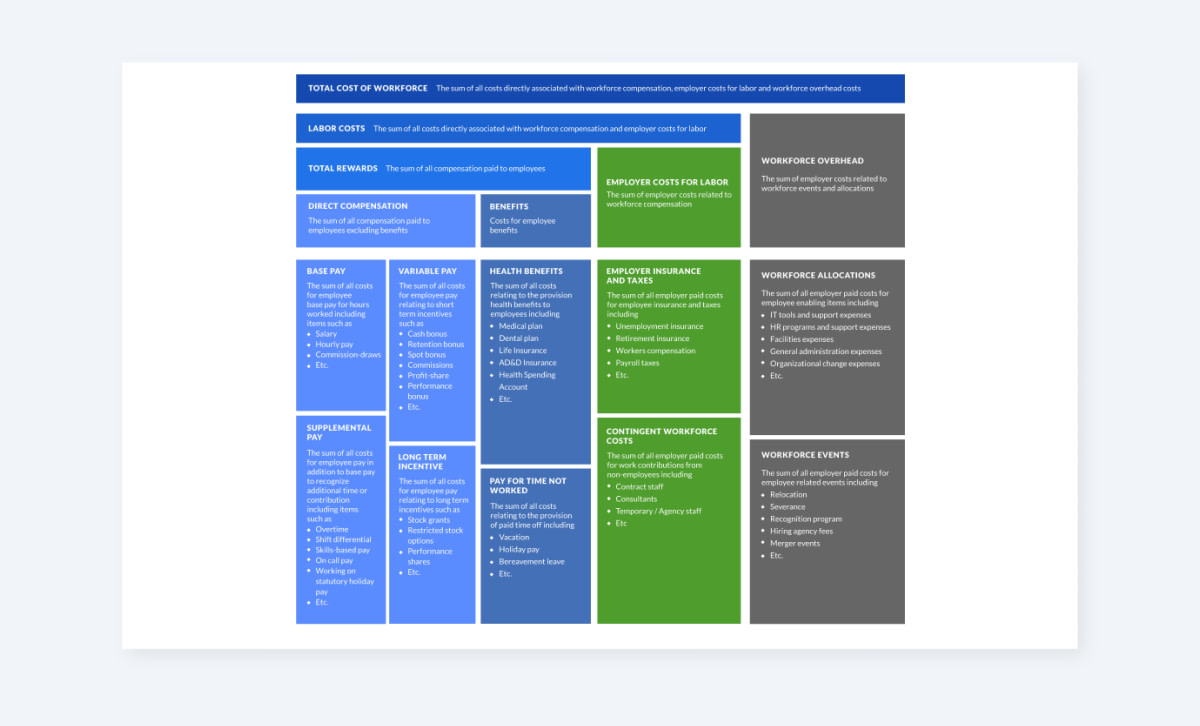Rising Wages: Time to Know Your Total Cost of Workforce (TCOW)
Your total cost of workforce (TCOW) is about more than just your total compensation figures. Use this post to get the most from your TCOW.

Frontline employees for companies conducting a substantial amount of work with Facebook are probably “liking” a recent announcement made by the social networking powerhouse. In May, Facebook announced a new set of standards for vendors and contractors with respect to employee pay and benefits. This includes a $15/hour minimum wage, sick time, vacation, a $4,000 new child benefit for new parents who don’t receive paid parental leave, among other things.
This makes Facebook part of a growing number of brand-name companies in the United States that have recently announced increases around pay and benefits — increases that surpass the federal minimum wage standard of $7.25/hour. And as a recent Economist article indicates, the market is taking notice.
Changing Cost of Workforce: There Are Decisions to be Made
Announcements like these create a movement in the cost of labor. Walmart and Facebook are “marketing” to the workforce through their messaging and placing pressure on other organizations to match the pay and benefits offered or risk losing their people.
Organizations that compete for talent with the likes of Walmart, the Gap, Target, or the vendors and contractors of Facebook, can expect to see wage and benefit pressures increasing the rates of vacancy and resignation within their workforce. The most likely response is a corresponding increase in pay and benefits to match these major employers.
However, simply following the lead of others can lead to wasted spending. How, when and where to change pay and benefits is a strategic decision that requires careful prior analysis to ensure any money invested impacts the organization in the way intended.

Considering Increasing Pay? Consider This
If you are adding to pay and benefits, to keep up with the market, there are a number of things that you need to consider.
You need to make sure you are adding in the right places. Places (locations, departments, roles, etc.) that drive performance or support retention – it shouldn’t just be a blanket addition to costs.
From a pay perspective, you need to achieve the right balance of base and variable so that if things slow down you have the flexibility to adjust overall costs, without having to terminate people and endure the costs that this brings.
You need to know how you compare not just on base pay or health benefits but across the full range of total rewards items. The total package provided to your employees may already be better than the standards being set by others. You can make the most of this situation by understanding this and communicating it.
In addition, you need to plan out how your cost changes will impact the organization over the medium term – the next 24-36 months – so that you can factor this into future budgeting and business results projections.
What the CEO Wants
Presenting cost increases to the senior executive requires more than pointing to the fact that someone else is doing it. Being able to backup the proposed solution with a clear analysis of the context around the business, as well as specific internal factors which impact the business is critical. To do this you need access to your data, and the right combination of business acumen and analytic capability in your team.
HR is uniquely positioned in terms of its knowledge and understanding of the workforce and organizational requirements and dynamics. Being able to quickly model what high profile trends might mean for your workforce is the type of proactive HR that the CEO is looking for. The ability to model the impact of wage and benefit increases to total budget and then run a series of scenarios to determine how best to manage the increase in costs allows your company to respond to market pressures effectively, address the key considerations above, and not simply “chase” after labour.
Know Your Total Cost of Workforce (TCOW)
Doing this right means understanding your Total Cost of Workforce (TCOW) – the full cost for people who contribute work to the organization, including all of the labor costs and the workforce overhead costs, and all the costs that roll up into those two categories. Yes, TCOW is more than just your total compensation figures. Why is TCOW important? Because it gives you an understanding, to the last cent, of what changes will mean to your business. This level of insight is critical to fully communicate how your changes will affect the costs of the business, whilst driving outcomes which support business success, e.g. retention of critical staff and high performers.

Getting the Most From Your TCOW
Most organizations, regardless of size, do not have a clear line of sight to their TCOW. Typically HR holds certain data (e.g., headcount, salary and benefits information), while Finance holds the data on the workforce overhead. Often data is kept in separate systems that don’t talk to each other, so calculating the Total Cost of Workforce becomes a time consuming, manual, process that happens once per year and is very prone to error.
This is how modern analytic solutions, where domain expertise is embedded in the technology, are a huge benefit to HR. Instead of having to develop your own model for TCOW and go through the process of aligning all of this with the finance department, you can bring all of your data together in one source and map it to an expert model that has already been created and tested. This moves the work of the analysis away from agreeing what data is where and more towards understanding the impacts of decisions and how to develop the relevant outcomes.
Through integrating your analytic work with workforce planning scenarios, you can create projections of what the change will cost this year, next year and beyond. Using a common definition of TCOW and integrating your analytics and planning processes means your response will reflect the full business cycle and enable the organization’s executive team and board to manage the immediate and longer term needs of the business.
The final stage is to be able to package and present this analysis into a clear and logical story. It is not enough to know that your answer is correct, you have to be able to prove to others that the process by which you got to your answer is well thought through, based on evidence and has the best chance of helping the organization succeed.
Responding Strategically in a Tight Labor Market
The labor market is getting tighter and more and more leading organizations will be vying for the attention of the workforce. Simply copying the moves of these market leaders will cost your organization too much money and is likely to create a legacy of fixed costs that become hard to unwind when the business cycle does turn down again – as it always does. Instead of copying others, you need to take an analytical approach, that identifies where you will gain the most advantage from adding to the costs of your workforce – and plans for the longer term as to how these cost increases will be managed or reduced as the business cycle changes.
Simple as this sounds, it is not easy to deliver. Those organizations that have been investing in workforce analytics technology and team capacity will be well placed to develop a strategic response. Those who have not will find themselves outmaneuvered, struggling to respond effectively.
If you are looking to get started with the right type of response then the place to start is analyzing your total cost of workforce, identifying how this impacts retention of high performers and vacancy rates across key business units. From what you learn here you need to develop, model and cost a range of responses that will keep talent where it is needed, whilst limiting the fixed cost increases impacting the organization. Finally you need to share this with your executive team in a clear compelling story so that they become partners in the decision making and implementation process. Of all of these steps the most important thing is to start and start now.
Get Outsmart content straight to your inbox
Subscribe to the People Insights Monthly newsletter for actionable insights and stories.
Subscribe now